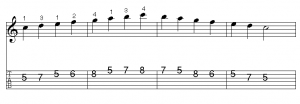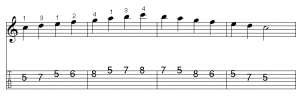Ways to Practice Classical Guitar Scales
One of my favorite ways to practice anything is changing rhythms. The simplest way to apply this concept to scales is to use “swing” rhythms. Let’s take a look at this one octave scale:

We can change the even rhythm to a dotted eighth + a sixteenth. We can also do the opposite: a dotted sixteenth plus an eighth. I recommend “over-dotting” the eighth notes for these rhythmic variations. That is, play the eighth note longer than normal and keep the sixteenth short.
Practicing this way creates small bursts of speed between notes. Using small bursts is one of the most effective ways to teach your fingers to move quickly while staying relaxed.
Doubling, Tripling & More
My other favorite rhythmic variations for scale practice are doubling, tripling, and quadrupling the notes per beat. Set your metronome to a tempo at which you can do a scale in sixteenth notes. Start by just playing one note of the scale per beat.
Then two
Finally three and four notes for each beat.
Keep the metronome set to the same tempo for each exercise. You can hear all this on the audio track below. These rhythmic variations can be applied to scales of any length.
Any of this can be applied to any scale of any length. Try it out!






